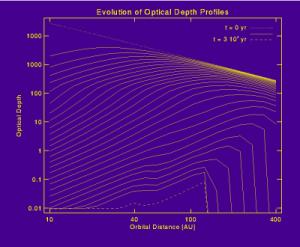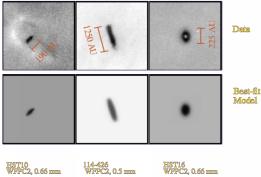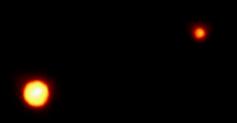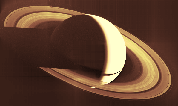
I'm looking at planetesimal formation within the Orion nebula. In HST images, several dozen large 'dark disks' are seen - dark only because they are blocking the light from the ionized gas of the Orion nebula region, silhouette-style. These disks may well be young solar systems in-formation -- like ours, but younger, perhaps 106 years years old. The disks are composed of gas & dust: the dust is what blocks the light, and the gas is what supplies most of their mass.
The Orion region itself is visible
predominantly because of the
Trapezium stars, OB stars which ionize the region nearby. Besides
lighting up the whole area like a flashlight, UV photons from the
Trapezium are tearing apart the disk like a cosmic leaf-blower
attacking a pile of sand. Models of planet formation that ignore
the effect of the OB stars may be skipping a good part of the physics!

Planets form by collisional growth of small particles. But, particles can be blown away from the system by the hot wind blown off from the disks. If particles grow large enough, fast enough, they're safe, but small particles can be entrained and lost by the gas. We are modeling the growth of small particles is the photoevaporated disks.
We are also looking at planetesimal formation by gravitational instability -- a collective force that brings many small dust grains together. Although this method is not new, interest in it has been revitalized recently. Historically, gravitational instability is usually difficult because gas motions inhibit graisn from coming together. We are looking at methods where this can be mitigated -- for instance, if photo-evaporation removes the gas first, then gravitational instability can work subsequently.
Processes in the disk are turbulent. The main source of the turbulence is escaping heat which convects through the disk's atmosphere. The heat is generated both from the initial collapse of the disk, and from turbulent viscosity generated by shear within the disk.
Our model tracks the size distribution n(r,z,R,t) for particles in the disk. The particle growth process is a) collisional coagulation, and the loss processes are b) UV photosputtering, and c) removal of particles by entrainment in photoevaporating gas. We use a variable-timestep integrator to track the state vector for t ~ 106 years.
We find that, for typical input parameters,
the optical depth of the
disks is sharply terminated, at a distance R ~ 100 AU. Inward of this
distance, particle growth is fast enough that particles are large
enough (> 100 um) such that they are retained by the disk.
Outward of this distance, particle growth is slower, particles remain
small, and they are easily blown away by the escaping photoevaporative
wind. Furthermore, grains can quickly settle to the midplane; if this
happens and some gas is removed, then a gravitational instability in
the remaining dust can occur.

HST has been used to examine the disk images across the telescope's
entire wavelength range, 0.25 .. 2.2 um. In each case, the light
is generated behind the disk, photons pass
through the disk,
and we observe the silhouette of the disk against the bright emission
nebula. The interaction between a photon and a particle is strongly
dependent on their relative sizes; very small particles (r
<< lambda)
cause blue skies & red sunsets.
In the case of the proplyds, we found the disks to be not blue, not
red, but completely grey across the wavelength
range. This
implies that the typical particle sizes are at least several times the
wavelength, or
The presence of strong UV sources on a young disk appears to prevent the formation of large particles outward of 100 AU. Planets can't form there, because no planet-forming material there is safe from loss.
Formation of jovian-type planets may be affected in the inner nebula, depending on the growth speed of jovian cores. However, jovian-type planets may be formed if they're made quickly (e.g., Alan Boss's models of gravitational collapse), or in regions where they are sheltered from photo-evaporation (e.g., far from the Trapezium core).
The exact timescales are determined by a number of input parameters, some poorly determined: initial mass distributions, disk ages, projected disk distances, particle sticking probabilities, grain fractal properties, etc.

I am working with the instrument & science teams for Ralph, a visible-IR imaging spectrometer onboard the New Horizons mission to Pluto (and beyond!). The spacecraft launched in January 2006 and gets to Pluto in July 2015, after a Jupiter flyby in February 2007.
I wrote a slick web program (the New Horizons Geometry Visualizer, or just GV) which is being used by the science team to plan the encounter, and analyze a lot of the data from the Jupiter flyby. It is essentially a planetarium package, showing you what the sky looks like from New Horizons as it cruises through the Solar System. It can also be used for Cassini, Rosetta, Juno, and numerous other missions, as well as being very useful for planning observations from the Earth.

A
detailed light scattering model for realistic, icy, non-spherical
particles, as applied to Voyager and HST data. We compared the
present-day ring (location, optical thickness, particle size, radial
profile) to end-results from a variety of origin scenarios, as
predicted by the Roche-zone evolutionary model of R. Canup.

We
are also analyzing Galileo data of the Jovian rings, in
particular for particle size distributions, to be used to compare to
the output of long-term evolutionary models. We are currently working
on generating accurate phase curves and spectra of the main ring, based
on SSI and NIMS observations. Similar to our work with the G ring, we
are able to constrain the size distributions far better by using both
the spectra and phase curves than either one individually.
Size-dependent particle dynamics will be calculated using the models of
M. Horanyi, and formation histories constrained using the evolutionary
models of R. Canup.
Last modified 25-Feb-2010